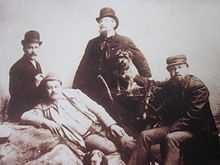Valerius de Saedeleer

Valerius Victor Emiel Marie de Saedeleer[1] (4 August 1867 - 16 September 1941) was a Belgian expressionist painter, one of the main figures in the school of Flemish expressionism.
Biography
Valerius de Saedeleer was born in Aalst, Belgium in 1867 as the son of a merchant. Refusing to work in his father's business, he left his parents and went to Ghent to study at the Academy of Fine Arts, where he met Theo van Rysselberghe and George Minne.[2] He moved to Brussels and became for four years a pupil of the impressionist Franz Courtens. He then started working as an independent artist, influenced by Courtens an Emile Claus and still searching for his own style. He lived at the Belgian coast for a few years, and then moved to Afsnee, near Ghent, where he met painter Albijn Van den Abeele. De Saedeleer moved to Sint-Martens-Latem for a few months in 1893, then lived for two years in Ghent and three years in Lissewege, before moving back to Sint-Martens-Latem in 1898. There he formed part of the first artist colony of the village, together with Gustave van de Woestijne and George Minne.[2] Many other painters later joined the socalled first and second School of Latem, most notably Constant Permeke, Albert Servaes, and Gustave de Smet. These painters moved away from the luminism of Emile Claus and his followers, and turned towards a more sombre, sober palet, with influences of late Medieval Flemish painting.[3]
Even though he had a first exhibition in 1901 in Aalst, he struggled to live of his work alone, and started raising poultry. The next year, he visited the Exposition des primitifs flamands à Bruges, which left a lasting impression and influence on his work. In 1903, he exhibited his landscapes at the Salon in Paris, where he was influenced by the works of Émile-René Ménard. The same year he converted to Christianity, and from 1904-1905 on, de Saedeleer started working in an expressionistic symbolism, a purified style, with mostly empty, silent, motionless landscapes, often in winter. He exhibited at the 1904 exhibitions of the Berlin, Munich and Vienna Secession, and some exhibitions in Belgium; he started getting attention in the media, and some collectors bought his works, like the large triptych The river (the Leie on a grey day). By 1907, he was the most successful of the painters from Latem, especially in the German speaking countries, who noted the influence of Eugène Laermans.[2] He exhibited at the Salon in Ghent in 1906, where he drew the favourable attention of art critic Karel van de Woestijne. In 1907, he had an exhibition in Ghent together with Maurits Sys and Gustave Van de Woestijne.[3]
In 1908, he moved to Tiegem, which reflected itself in some changes in his landscapes. The mostly flat sights from the Leie change to more hilly landscapes. His success remained, and in 1909 the musea of Ghent and Aalst bought some of his works; in 1911, the Belgian royal family bought his Smidse in de Winter, a snowy landscape.[2] He later exhibited at the "Pour l'Art" exhibitions in 1912 and 1914, and was one of the co-founders of "La Jeune Peinture Belge" in 1924.[3] In 1914 he moved to Wales to flee the First World War. Together with his family and the family of his friend George Minne he lived a number of years in Cwmystwyth. He remained there until 1920, when he moved to Etikhove, and in 1937 he again moved to Leupegem. In 1933, he became an honorary citizen of the city of Aalst.[2]
His style, the mixture of the Flemish expressionism with the tradition of Early Netherlandish painting, and especially the art of Pieter Bruegel the Elder, influenced some younger artists like Albert Claeys and Albert Saverys, as remarked by art critic Edmond Jaloux.[3]
Retrospective exhibitions were amongst others held in Aalst in 1967, in Oudenaarde in 1998, again in Aalst in 2000,[3] and in Deinze in 2006.
De Saedeleer married Clementine Limpens on 14 November 1889.[2] They had five daughters, of which the second, Elisabeth de Saedeleer (1902-1972), was an artist in her own right.[3]
Notes
- ↑ Sources varyingly use "de" or "De", but the books where de Saedeleer contributed all seem to use the lowercase "de" version
- ↑ 2.0 2.1 2.2 2.3 2.4 2.5 Boyens, Piet (1998). "Valerius De Saedeleer". Sint-Martens-Latem (in Dutch). Lannoo. ISBN 9789020934977.
- ↑ 3.0 3.1 3.2 3.3 3.4 3.5 De Smet, Johan (2000). "Valerius De Saedeleer". Sint-Martens-Latem: en de Kunst aan de Leie (in Dutch). Lannoo. ISBN 9789020941531.
| Wikimedia Commons has media related to Valerius De Saedeleer. |
- 12 Paintings by Valerius de Saedeleer at the BBC Your Paintings site
|